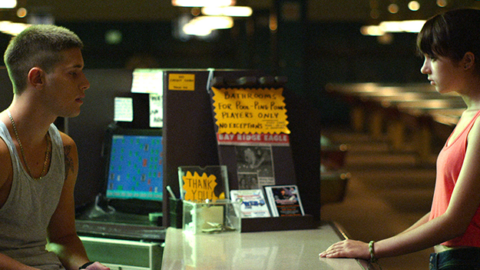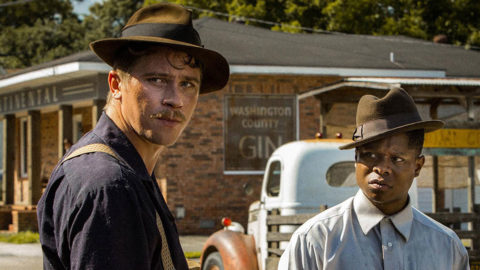Interview: Eliza Hittman
Progress—be it economic or social—is always uneven. A microcosm of this harsh truth is Brooklyn, a borough that commands some of the highest real estate prices in the city of New York, but where two out of five households fall below the minimum income for self-sufficiency. Eliza Hittman’s Beach Rats touches on this inequality by virtue of its location (Gerritsen Beach, a neighborhood in far South Brooklyn so far untouched by developers) and protagonist, a young adult who has extremely limited prospects in life or love.
At first blush, Frankie (wide-eyed newcomer Harris Dickinson) seems to be a typical beach rat: unemployed, blonde, and buff. He spends most of his time getting high with friends and wandering around Jacob Riis Park, but there’s an undercurrent of insecurity and unhappiness that his swagger can’t hide. Frankie’s father is dying (which provides him with a steady supply of painkillers), and at night he frequents a ChatRoulette-like gay cruising site. Over the course of the summer, he attempts a relationship with cute and confident Simone (a sharp Madeline Weinstein), but also becomes more confident about meeting up with guys. Eventually, his private desires and daytime friends meet in a harrowing seaside confrontation.
Like her previous feature, It Felt Like Love (2013), Hittman’s camera hones in on these youthful bodies, intimately documenting their moments of uncertainty and states of becoming. Film Comment Digital Editor Violet Lucca spoke with Hittman about fashioning this slight but powerful narrative last week in a coffee shop in (gentrified) South Williamsburg.
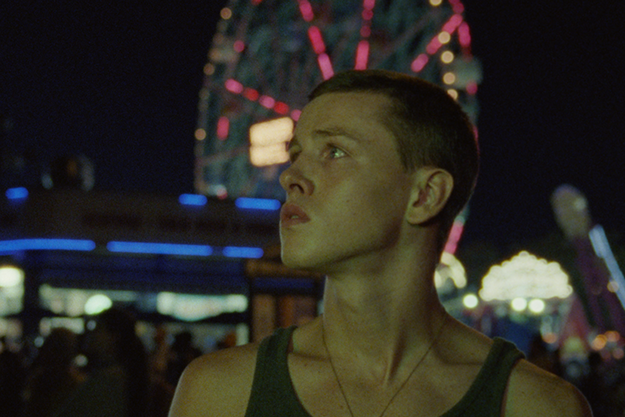
What was the genesis of the story? Did you talk to men about their sexuality and coming of age? How did it begin?
I was struggling after It Felt Like Love for a couple of years to figure out what exactly the film world was expecting me to make next. And I was very lost in trying to navigate both the industry and how to have a career and all of those things. So I decided not to think about any of those things and just go back and do what I had done before, but on a broader canvas. There were a couple of moments that I took note of while I was shooting It Felt Like Love. We were shooting along the water and we noticed that there was still a lot of cruising happening, and that was one thing I filed away in my mind. I cast a couple of kids from Gerritsen Beach, Brooklyn, and those boys are called “beach rats,” and I took note of that being a good title for something. When I got to Sundance in 2013, I started pitching another movie with the title Beach Rats that was about these guys. Throughout It Felt Like Love I did a lot of looking through Facebook pages and appropriating images, and I found one image that became the generative image for the film.
I was also thinking a lot about the guys from It Felt Like Love and how isolated they are class-wise and how those neighborhoods have a long history of violence that erupts when you introduce any otherness into an isolated group. They’re very far from the subway and they don’t have a lot of opportunity. Those were the things circulating in my mind when I started writing the film. I wanted to explore male sexuality as a kind of a companion—even though I have been told not to call it a companion to It Felt Like Love—but the characters are very similar to me. They’re both trying to conform to expectations around them even though they don’t quite fit into their worlds.
You really nailed that feeling of deep, deep South Brooklyn, and also the widespread use of Oxycontin and painkillers, which nobody really talks about.
I was aware of it also because some of the kids in It Felt Like Love had big meth problems. There was a kid in It Felt Like Love that was a hip hop artist named Nyck Caution and a lot of the music that he was writing was about how all of his friends had become heavily addicted to pills. I think that all those issues go hand-in-hand—isolation, no opportunities, drugs, and what it means to contend with identity issues in that world.
It shows the paradox of modern life where everyone is super-connected all the time because of smartphones and the Internet—anytime he wants he can dial up a guy for marijuana—
—It’s all just for drugs!
But also sealing yourself away and taking pills to a point where you can’t even articulate anything.
And the general inarticulateness of guys that age especially when dealing with things that they don’t know how to process, and then it kind of implodes and explodes. It will create a disastrous event either for them or for somebody else.
Male sexual awakening is taken for granted in film. Guys are made to seem like they were born horny, or it’s just treated as setups for jokes. Did you talk to men about their experiences or were you transposing your own experience onto this?
I took a lot of experiences I had with vulnerable men and learning how they cope with their own fragility in bed, and wrote from my own experiences. It was hard, at first, wondering, “Can I tell this story?” And then I thought about how so many of my favorite films about female sexuality have been written by men. So I gave myself permission to try. Beach Rats is not a coming-of-age story or a coming-out story. I think about it as coming to consciousness about who you are, which can be a painful process for people.
There’s been a lot of discussion about Moonlight representing—I don’t even want to call it a “coming-out story”—
It’s not a coming-out story. He never comes out.
Right! But Moonlight has been criticized for not being explicit enough in terms of representing sex.
As a filmmaker, I wish I could be more explicit, but it’s just so impossible in this country.
For ratings reasons?
For ratings reasons, casting purposes. In films like Stranger by the Lake they use body doubles, and it was a lot to ask from the financing company. I knew that I wanted to attempt to normalize male nudity in the film without being overtly provocative, but I knew there was a line that I couldn’t cross.
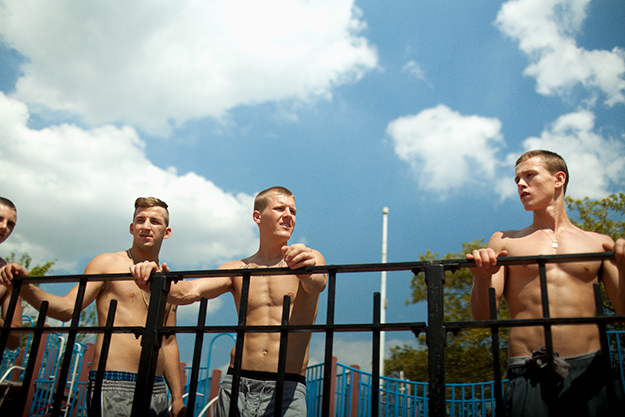
With It Felt Like Love, your lead actress flagged things in the script that she didn’t feel comfortable with. Can you talk about working with non-actors again, and if you went through a similar negotiation?
I didn’t. At first when the casting director and I started sending the script out, I got very negative responses from agents who were very flippant, and saying, “All this male nudity and gay sex!” It wasn’t something they wanted their clients to go up for, so I wasn’t drawing from a huge pool of actors. Harris Dickinson, who plays the lead role, actually sort of snuck into the mix of casting tapes from an L.A. office and I didn’t know he was actually U.K.-based. He sort of tricked us. He was 100 percent committed from the beginning and had zero questions about that stuff. He had watched my other film and knew it would be handled sensitively and delicately and he knew the crew was going to be small, so we didn’t have the same dialogue. He was a bit older too—he was 19. He was very brave and very committed and knew what he had signed up for and there was no backpedaling.
Do you feel that it is important to push that line of explicitness or showing things that aren’t often shown?
I do. I really liked Love, the Gaspar Noé film, because I thought the sex was staged so beautifully and it was very balletic. I am intrigued with films that push those boundaries. But it’s hard to do that as a filmmaker here. You will always be battling and you always have to choose your battles, and it’s hard enough to get your movie made in the first place!
I was surprised to find out that Harris is from the U.K.
He’s from a similar area in London. Along the water in Gerritsen Beach it’s a mix of Irish and Italian-American and Russian and Albanian and Central Asian, so he blended in a convincing way, I hope. He understood the world without having been there at first.
It is such seamless casting, even though he’s got such Anglo features. It feels like he has to be from there, like a blonde Sicilian or something.
“He’s Irish-American!” was our justification.
The storyline with his terminally ill father, is that based on your own experiences with your mother being ill when you were in high school?
For me I have always associated adolescence with being surrounded by illness. And I was also thinking a little about The Stranger and the narrative of someone who loses a parent and does something unforgivable without being able to justify or process it.
Yeah—that carelessness of youth and how it can snowball into something terrible so quickly. When Frankie and his friends are stealing his mother’s earrings for weed money and they catch Frankie’s sister with her little boyfriend, someone sitting next to me gasped. It could’ve gone such a different way.
I wanted to set up those moments of small tension that build to a larger event.
It’s such a simple and straightforward story. How did you go about structuring it?
I wrote an early draft that was a mess and was almost all behavioral about this kid going back and forth between worlds. And then I took it to the Sundance screenwriting lab and everybody was like “There’s no progression!” So I went back and built in a major progression to the story—that was the major rewrite of the script. In the first draft there was no progression of him waiting for his father to die before testing the waters—he was already in motion. The first draft had extreme behavior and almost no causality, and everybody was like, “Uh, this needs some causality!” There is plotting but it’s very simple.
I also wanted the sister to have a small narrative of this simple, earnest love affair that makes her brother, in some way deep down, envious of her. She can have this simple attraction and growing experience. On the surface he seems like a hyper-masculine, overprotecting brother, but actually there is a deeper envy. Her part is small, but you sense that she blossoms over this summer. I also wanted to make really simple narrative structural decisions rather than thinking about the emotional melodrama of losing a father and the bigger feelings of grief, [instead] suppressing the tensions of those things in the characters.
Did you revisit any other films to help you through that?
I didn’t. It was a tumultuous period of my own life where I was juggling a full-time teaching position and a child, so it wasn’t a period of extensive movie watching. My hours to just get lost in the story were much more constricted.
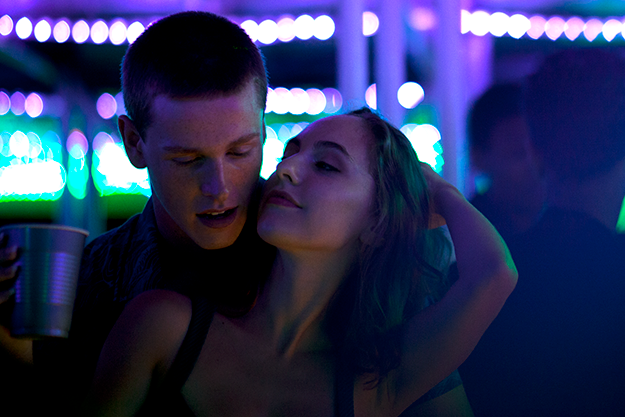
It’s like that Onion article “Find The Thing You’re Most Passionate About, Then Do It On Nights And Weekends For The Rest Of Your Life.”
If I could stay up all night! In terms of visual inspiration, I did look at a few things. White Epilepsy and other Phillippe Grandrieux films were interesting to look at, and thinking about how he was able to construct atmosphere through darkness and the primal feeling of that piece. We looked at Sombre and those works for lighting inspiration, and ended up with a very simple lighting plan for all the nighttime stuff that was very inspired by the lighting strategies of that film.
White Epilepsy has a specific frontal lighting, and that was how we lit everything. That unmotivated, frontal light. The way we talked about it was like shining a light on an animal in the darkness and catching something moving. It was a strategy that made people nervous because everyone wants everything to be motivated in film, except a score. So it’s not going to be a streetlight or a cell phone light or moonlight, it’s just going to be a light.
That choice definitely makes certain scenes more harrowing, and makes it clear that we are watching a film, that it is a construction. Not making it artificial, but just a reminder that you can see what’s happening in the sense that the narrative allows you to see what’s happening.
It was definitely a hard setup for everybody else to grasp. The gaffer was like, so you hired me for this shoot to hold a light on a stick for a few hours? I like shooting light and I’m not a complicated person. I fought for just 16mm and a simple night lighting plan and almost nothing else, no Steadicam, no dollies. We did a test and experimented with the lighting with LED lights, and everybody was trying to push me more digital because it’s more light sensitive, but I wanted darkness and to create this sense of place through darkness. It’s really about a character confronting himself, and how he perceives this part of himself as being dark.
Was the way the fireworks function in the narrative always part of the plan?
It was part of the plan and it comes back again to those rhythms. There are all these seedy bars in Coney Island and these kids always go out for the fireworks and there’s a bar near the boardwalk that they all go to. This sense of routine and myth of romantic love and these two people trying to have this romance and failing, but trying. I wanted to play with the audience’s expectations to see this heteronormative love affair play out where they’re never going to fall in love, even though they are trying.
I love all those scenes with her, because Simone is this strong female character that doesn’t announce herself as that. It’s different from many films where it’s like, “Check out this strong female character, good for us, we did this!” Simone is just someone who knows what she wants and he’s not it, so goodbye!
She tries and she’s patient, and there’s something kind of sexy about his vulnerability and trying to help him through it.
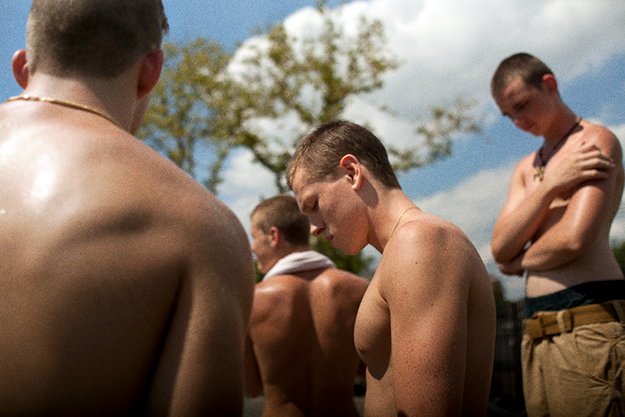
In light of Friday’s inauguration, I’m wondering if you feel a drive to be more political?
One of the projects I was working on before Beach Rats was about abortion tourism and the journey women take from places like rural Pennsylvania into New York City for things they can’t access where they are. I think there is this fear of Roe v. Wade being overturned and defunding Planned Parenthood, and I feel like that story is much more urgent now than when I was developing it in the first place. So the story I’m working on is about two friends who hop a Greyhound bus and spend 48 hours in New York and navigate this thrilling city for the first time, as well as their own personal crisis. So it’s a story about female friendship and the lengths that women will have to travel and the hell that is a woman’s life when she loses control of her rights. I’d like to actually shoot next year because it’s something that’s queued up [by Trump’s presidency]. I like to keep doing work and not worry about expectations.
It feels so hard to get people to pay attention to any film now, but you have found ways of getting this very straightforward, non-formulaic Sundance film made that doesn’t just check boxes because it has to.
I owe it all to Cinereach for taking me into their organization and finding a way to support the film because I don’t know if anyone else would have. It was a really bizarre movie to pitch and actually felt dated to people, and/but now I think it feels more relevant, unfortunately. But I don’t think that people were thinking about class issues, obviously, when I was talking about the film in its early stages.
Or that it’s still not okay to be out in large parts of this country, but a lot of white, gay men who work in media find a coming-out narrative passé—but that’s not the case for everyone!
There is no coming out in that world [in the film]. There’s leaving, and he’s not capable of leaving yet. So the Internet, as it is for many people across this country, is a channel to understanding yourself.



